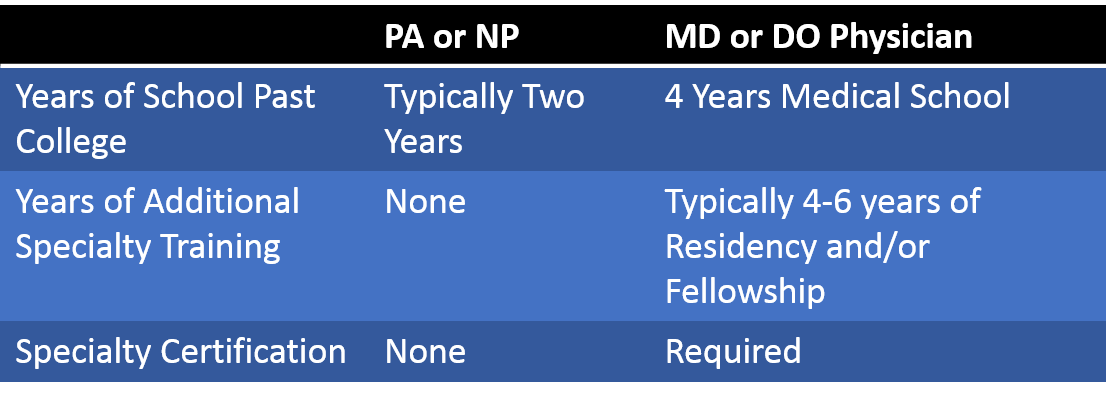The Mid-Level Shuffle
This week I’ve had two physician assistants contact me looking for a job injecting Regenexx patients as they had been previously employed by stem cell clinics. I had to tell both of them that at Regenexx we don’t allow mid-levels to perform our procedures. So what’s a mid-level, and why could this be a problem at some stem cell and PRP clinics?
What Is a Mid-Level?
Given our mill-type medical-care system, if you’ve been to the doctor a few times in the last decade, you’ve more likely seen a physician assistant (PA) or nurse practitioner (NP) than the actual MD or DO provider. These lesser-trained and less-experienced providers are called mid-levels. Let’s compare and contrast the training between these health care workers and the actual doctor.
As the chart above shows, a mid-level has far less training than a physician and has no specialization. In fact, many doctors train longer in a specific area after medical school than the length of time they spent in general medical education. Hence, if you see a mid-level, you’re never going to get the same level of expertise as you can get by seeing the “real doctor.”
The Stem Cell Clinic Mid-Level Shuffle
Stem cell treatments can be pricey, typically in the $4,000–$10,000 range. In essence, many of these procedures are as expensive as a typical plastic surgery procedure. However, patients signing up for a facelift, liposuction, or breast augmentation would never let a physician assistant or nurse practitioner perform the procedure; they want a highly experienced and expert surgeon to be the one sculpting their new visage. Why then would a patient allow a mid-level to perform a stem cell procedure? Let’s explore that further.
First, many patients might not know that the provider they are seeing in their chiropractor’s office or in their orthopedic-surgeon’s clinic isn’t a real doctor. I’ve seen some mid-levels that are introduced as “Doctor…” Second, most patients just believe that these procedures are simple joint injections; however, they are not. Take a minute to look at these specific videos to see that these procedures, done correctly, are microsurgery performed through a needle, which would be inappropriate for a mid-level to tackle.
Dr. Pitts Performs a Neck Procedure
Dr. Schultz Performs a Shoulder Procedure
Dr. Centeno Performs an Ankle Procedure
Why Would a Stem Cell Clinic Not Use a Real Doctor?
Physicians who are highly skilled in how to inject specific structures inside a joint using ultrasound and fluoroscopic guidance are few and far between. Hence, they are expensive, generally costing the clinic three to four times as much as a mid-level. Hence, if you’re a clinic that wants to maximize income, the best way to do that is to hire a mid-level to perform the procedures. Is this the best for the patient? Nope. But if the patient has no idea that he or she is being cheated, who cares?
The upshot? Mid-levels should not be performing stem cell procedures, period. You now know the difference. If you find that the person who is performing your injection is a mid-level, don’t walk but run to the exit! Now you know the difference, so don’t be cheated out of the expertise needed to perform these complex injections!

If you have questions or comments about this blog post, please email us at [email protected]
NOTE: This blog post provides general information to help the reader better understand regenerative medicine, musculoskeletal health, and related subjects. All content provided in this blog, website, or any linked materials, including text, graphics, images, patient profiles, outcomes, and information, are not intended and should not be considered or used as a substitute for medical advice, diagnosis, or treatment. Please always consult with a professional and certified healthcare provider to discuss if a treatment is right for you.
